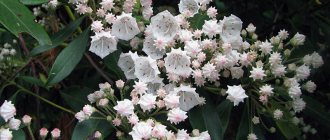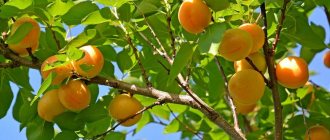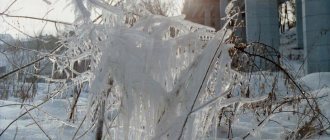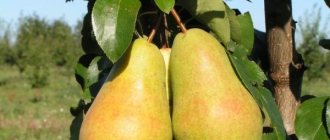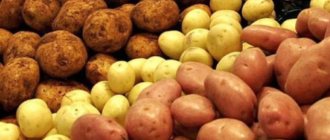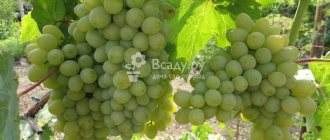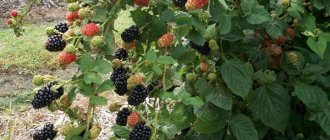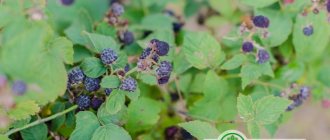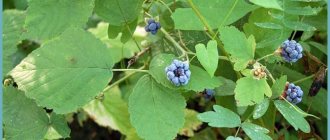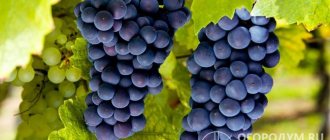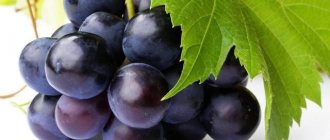Blackberries are a perennial shrub whose berries are similar in shape to raspberries, but darker in color, most often they are black or dark purple with a glossy sheen. It is believed that blackberries contain more fructose, glucose, fruit acids, pectin and other health benefits than raspberries.
In the wild, blackberries grow in wooded areas in partial shade. Garden blackberries began to be bred mainly by American breeders; they also hold the leadership in the production of this crop on an industrial scale.
According to their shape, the shrub is divided into two types - bramble and dewberry:
- Kumanika are upright growing bushes with shoots growing up to 3-4 m in length; they can be thorny or thornless. Such blackberries reproduce by root shoots and by growing cuttings. Most types of brambles are highly frost-resistant.
- Dewberries are shrubs with creeping shoots, whose vines grow up to 5-6 m. This type of blackberry is propagated by rooting the tops of non-fruiting shoots. Dewberries are distinguished by more tasty fruits. Their bushes and roots are less resistant to frost, but they are easier to cover or bury in trenches before winter.
Varieties of remontant blackberries
Remontant blackberries appeared at the beginning of this century, but are rapidly gaining popularity due to the ability to harvest from the current year's shoots. In the temperate continental and continental climate of Ukraine, Belarus and most of Russia, there is a high risk of shrubs freezing in winter or damage to flower stalks from spring frosts. However, the ability to remove the above-ground part of the bush for the winter makes these varieties invulnerable to the vagaries of the weather, rodents, insects and many diseases. This makes it easier to care for the crop: there is no need to pile up special shelters for the winter, or once again treat the bushes with chemicals.
Remontant varieties of blackberries are, as a rule, large-fruited, productive, their shoots are upright, their fruit branches are thornless, and their bushes are compact.
Reuben
Reuben is a relatively thornless remontant blackberry. The height of the bush is 170-180 cm, the shoots are straight and strong. The average weight of the berries is 10 grams; in an annual crop, they begin to ripen in mid-August and ripen until the autumn cold. The shrub is frost-resistant, tolerates drought well, bears fruit safely in partial shade, and is unpretentious to soil fertility.
Black Magic
Black Magic (Black Magic) is an unpretentious variety of remontant blackberry, the yield of which is not affected even by extreme heat, so Black Magic has gained wide popularity among gardeners in the South of Russia. The bushes are tall with thorns, but there are no thorns directly on the fruit branches. The berries are dark purple in color, large, weighing up to 10-12 grams, and tolerate transportation well. The yield of one bush is 5-6 kg.
Prime Ark 45
Prime Ark 45 is a shrub that is afraid of severe frosts, but is resistant to drought. Productivity is high. The average weight of the berries is 9 grams, they are glossy black, sweet, aromatic, and do not spoil during transportation. The bushes hardly get sick and are not affected by pests.
Prime Jim
Prime Jim is a new hybrid, little studied in Russia, all that is known is that the shoots are straight and of medium size. For winter, the bush is cut completely to ground level. The berries are elongated, sweet and sour with a mulberry flavor.
Prime Jan
Prime Jan is a new product among the remontant blackberry varieties. It has high adaptation characteristics to any climatic conditions. The shoots reach a height of two meters and are powerful. The berries are medium-sized with a distinct apple flavor - very tasty; they ripen from late August or early September until frost.
Prime Ark Freedom
Prime Ark Freedom is the first thornless variety of remontant blackberry with early fruit ripening. In America it is grown in industrial quantities. If there are errors in care, it is prone to anthracnose. The bushes are straight, not spreading. The berries are sweet, elastic, weigh 9-15 grams, and are easily transported.
general description
Garden blackberries are especially common in the middle zone; they are planted less frequently in the south. Breeders offer representatives of the crop for different weather conditions and climatic features. Previously, the berries were collected in the forest, but now they are grown in private plots. Blackberries can be eaten, made into jam, or made into infusions.
Expert opinion
Stanislav Pavlovich
Gardener with 17 years of experience and our expert
Ask a Question
Important! Modern blackberries are the work of breeders over many years. Unpretentious in care and cultivation.
Traditional berries are gradually being squeezed out, giving way to a new crop. Breeders have greatly changed the natural qualities. Plants survive better, berries have become larger. There are even varieties without thorns for ease of harvesting.
The best varieties for central Russia, Moscow region
In central Russia and in particular in the Moscow region, in recent years winters with little snow have begun to be observed, as well as unstable weather, when in the off-season thaws often alternate with severe frosts. Under such conditions, blackberries must be selected with high frost resistance of shoots and roots, since the roots on which the buds of future shoots are located cannot withstand freezing of the ground below 12-15 degrees, and the thin roots that absorb nutrition and moisture die already at 5-6 degrees below zero. . The blackberries described below are highly frost-resistant, but still sometimes require additional shelter for the winter.
Agavam
Agavam is an old, time-tested variety of blackberry that tolerates frosts well down to 30 degrees, is also drought-resistant, shade-tolerant, is not afraid of temporary flooding of the soil, is resistant to pests and diseases, the berries are rich in nutrients. The bushes are thorny and spread widely due to the many basal shoots. Medium-sized berries, weighing 5-6 grams, the taste and aroma of which are always at the highest level, do not lose intensity even in drought or waterlogging.
Detailed description of the Agavam variety.
Darrow
Darrow is a tall shrub, winter-hardy and productive. The stems are powerful, abundantly covered with prickly thorns. The berries are sweet and sour, average weight 4 g.
Wilson Earley
Wilson Earley is a winter-hardy variety with early ripening berries. The bushes are tall with drooping tops. The berries are black-violet, sweet and sour, oval in shape, weigh up to 2 grams.
Tornfree
Tornfree is a thornless shrub that belongs to the dew family. The vines grow up to 5-6 m and need shelter for the winter. The berries have an exceptionally sweet taste and, when fully ripe, weigh 5-6 grams and do not last long.
Detailed description of the Thornfree variety.
Black Satin
Black Satin is a thornless hybrid, the donor for which was the Thornfree variety. Shoots can reach 4 m in length. At first they grow upward, then they bend strongly towards the ground and need to be covered with peat or textiles. The average weight of the berries is 8 grams, they have a rich sweet and sour taste, black with shine.
Detailed description of the Black Satin variety.
Apache
Apache is a frost-resistant, high-yielding shrub, without thorns, rarely gets sick, and is not affected by pests. The berries begin to ripen from the beginning of July; they are sweet, black in color, and weigh up to 10 grams.
The remontant varieties described at the beginning of the article are also suitable for cultivation in the climatic conditions of central Russia and the Moscow region, provided that these blackberries are grown in an annual cycle. In this case, later in the fall it is necessary to completely cut off the upper part of the bush, and carefully mulch the root system with a layer of peat or humus 10-15 cm thick.
Blackberry Chester
Chester blackberry is an old, well-known, thornless, large-fruited variety of late-ripening blackberry.
The declared yield is 15 kg per bush. The berries are round, sweet with a slight sourness, weighing from 5-7 g, ripen in late July or early August.
The plant has a semi-creeping bush shape. No more than 5-6 shoots are left for fruiting, which grow 2-3 meters long.
Despite frost resistance down to -26ºС, shelter is required for the winter period.
When planting, you must maintain a distance of 2.5 meters between bushes.
Advantages and disadvantages of Chester
Advantages:
- frost resistance,
- absence of prickly thorns,
- excellent yield,
- good transportability of berries,
- The variety is resistant to major diseases and pests.
Flaws:
- the berries are not too large,
- winter shelter is required.
- does not like shade and low swampy areas
Blackberry Kiowa Kiowa (Kiowa)
The Kiowa blackberry was developed in 1996 in Arkansas. The bush is upright. The length of the shoots is about 1.5 m. But the garter is required for the trellis. The shoots of the bush are thorny.
Kiowa bushes are very productive. The berries weigh 10-12 grams. The berry is black, good taste. It can be eaten fresh and is hard enough to be used for transportation.
The undoubted advantage of the variety is long-term fruiting. He gives away the harvest within 6 weeks. The size of the berry practically does not change from the first to the last pickings.
Productivity largely depends on growing conditions. Bushes require shelter in harsh conditions. Blackberries are rust resistant.
Advantages and Disadvantages of Kiowa
Advantages:
- very productive variety, large and tasty berries,
- long fruiting season
- good transportability.
Flaws:
- thorny shoots,
- low frost resistance,
- the need to cover the bushes annually for the winter.
Blackberry Black Satin
A thornless variety of American selection, blackberry shoots are semi-creeping, 3-5 m long.
The berry is black, shiny, 5-8 g, the taste is sweet and sour, the berries must be picked after 3-4 days, when overripe, transportability is low.
In the middle zone it requires shelter for the winter. Fruiting begins in late July - early August and lasts until late autumn.
The best varieties for the Urals and Siberia
Considering that the Urals and Siberia do not have a very large number of sunny and warm days a year, for growing blackberries you need to choose frost-resistant varieties with early or medium ripening. However, one must take into account that super-early varieties are not suitable for this climate, since spring frosts at the end of May or beginning of June will be destructive for the plant blooming at this time. Remontant blackberry varieties also do not take root well in the harsh climate of the Urals and Siberia. Even if you grow blackberries in an annual cycle and cover the roots well for the winter, you will not be able to get the full potential harvest. Most of the fruits do not have time to accumulate sugars and ripen before the cold weather. Still, for the Urals and Siberia there are some upright growing varieties of blackberries, and also for the climate of these regions some frost-resistant creeping varieties - dewberries - are suitable; to protect them from frost, they are placed in shallow ditches in the fall and covered with humus, peat or plain soil.
Eldorado
Eldorado - blackberry with increased winter hardiness, bushes that grow upright, strong, with large thorns. The berries ripen in August, taste very sweet with a refreshing sourness, weigh up to 3-4 grams. Eldorado is picky about the soil - it grows well only on fertile soil and is shade-tolerant.
Erie
Erie is a winter-hardy and drought-resistant variety of blackberry, unpretentious to the soil, tolerates partial shade well, and rarely gets sick. The bush is spreading, the root system grows to a depth of 80-90 cm. The berries are sweet and sour, with a raspberry flavor, weigh up to 3.5 grams, ripen from mid-June to mid-August.
Snyder
Snyder is a blackberry that reproduces well, prefers fertile soil, and does not tolerate drought. The berries are large, tasty, but not transportable. The bushes grow upright, covered with multiple thorns.
Oregon (Oregon Thornless)
Oregon (Oregon Thornless) is a creeping shrub without thorns, winter-hardy. The berries are black, weighing 5-6 grams, sweet and sour taste with a predominance of sweet, ripen from early August to early September. The yield of one bush is 10 kg.
Darrow
Darrow is a winter-hardy hybrid with upright three-meter shoots. The berries are black and shiny, weighing 3.5-4 grams, sweet and sour, when overripe, they become insipid. The fruiting period is extended, the yield increases gradually from year to year.
Karaka Black
Karaka Black is a shrub with creeping shoots that can withstand frosts up to 15-18 degrees; at possible lower temperatures it needs shelter for the winter. The yield is high due to the large number of fruit branches; up to 14 kg are harvested from one bush. berries The fruiting period lasts 1.5-2 months, the harvest is harvested in several stages.
Detailed description of the Karaka Black variety.
Flint
Flint is an American variety that is resistant not only to frosts up to 40 degrees, but also to most diseases and pests. The bushes are straight and powerful. The berries are very tasty, weigh up to 5-6 grams, the average yield is up to 10 kg. from the bush.
Ufa Local
Ufimskaya Local is a relative of the Agave blackberry, but its berries are much tastier and more fragrant. The weight of the fruits is about 3 grams, they are well suited for freezing. The hybrid is characterized by high frost resistance, resistance to pests and diseases.
Ruczai
Ruczai - blackberry of Polish selection, late ripening, bred since 2009. The variety does not produce shoots and is winter-hardy. The bushes are powerful, tall, without thorns. The berries are large, sweet, black with shine. Productivity is high, transportability is at the level of industrial varieties.
Features of blackberries
Blackberry bushes are conventionally divided into 2 types: brambles and dewberries. Cumaniki are more reminiscent of raspberries. They have spiny stems that shoot upward. Old shoots must be tied to a support. Although most varieties of brambles are frost-resistant, they require shelter for the winter. They reproduce, like raspberries, by root shoots.
Dew bushes resemble wild shrubs. They have creeping shoots with or without thorns. Their yield and taste are superior to brambles. For propagation, shoots are buried and covered in winter.
Related article:
How to properly form blackberries. Six tips
Regular blackberry varieties have a 2-year development cycle. In the first year, the shoots grow, lay fruit buds, and in the second year they produce a harvest. Remontant varieties bear fruit on one-year and two-year-old shoots.
Interesting! Blackberries for your garden
Thornless varieties are very convenient for growing. Most of them are frost-resistant, so they are suitable for breeding in most of Russia.
Thornless varieties
Blackberry bushes without thorns are, as a rule, modern varieties, so they are distinguished by high commercial and taste characteristics of the fruit, are easy to maintain, but are often capricious to climatic conditions. When choosing a thornless blackberry, you need to carefully study its ability to tolerate cold and drought.
Navajo
Navajo is a thornless shrub with upright growing shoots. The yield is high, the berries are medium in size, weigh up to 5-6 grams, very tasty, rated at 4.9-5 points on a five-point tasting scale. The harvested crop is stored refrigerated for a long time and is easily transported.
Loch Ness
Loch Ness is a thornless variety of blackberry common in Russia, having semi-creeping shoots that require regular pruning. The berries are sweet, weighing up to 6 grams, have a rich composition of substances beneficial to health, turn black until fully ripe, so they often come to the market sour.
Detailed description of the Loch Ness variety.
Loch Tay
Loch Tay is a thornless variety of blackberry that is highly resistant to diseases and pests and has average frost resistance. Bushes of this blackberry are of medium size with strong growth of replacement shoots. The berries are medium-sized, weighing 5-6 grams, sweet, aromatic, and excellent wine is made from them.
Detailed description of the Loch Tay variety.
Chester
Chester - blackberry with creeping shoots. The berries are dark blue in color, not one-dimensional, taste mostly sweet, weigh up to 6-8 grams, are dense, suitable for transportation, and begin to ripen in mid-August. American farmers harvest Chester crops up to 20 kg. from the bush.
Detailed description of the Chester variety.
Helen
Helen is a hybrid of English selection, characterized by short creeping shoots and a small amount of shoots. The weight of the berries is up to 8 grams, they are very sweet, with a cherry aftertaste, the pulp of the fruit is tender and juicy. The berries are not suitable for storage and transportation.
Detailed description of the Helen variety.
The thornless varieties also include the varieties described in the article: Thornfree, Black Satin, Prime Arc Freedom, Ruben, Apache, Oregon, Natchez.
Features of cultivation
Blackberries are more unpretentious than raspberries, but to get a good harvest it is necessary to water, fertilize, pruning and weeding. An important point is the choice of planting material, place for cultivation and preparation of the area for planting. In the southern regions, most varieties do not need to be covered, but in the middle zone this procedure will be necessary.
In the northern regions, berries will have to be grown in greenhouses or using shelters.
The best varieties of blackberries
To grow blackberries for commercial purposes, you need to choose higher-yielding and easy-to-care varieties. Let's consider the most popular:
- Loch Tay (Scottish variety). First of all, it does not have thorns, which makes it easier to pick berries. It has a height of more than 3 m. Medium-sized berries (5 g) have good taste. The variety is high-yielding. The fruits ripen quickly and tolerate transportation well. The disadvantage is the need to install support structures (trellises) for tying up branches, as well as mandatory shelter from the cold in winter.
- Black magic. This remontant variety produces fairly large berries (10 g) with excellent taste and aroma. The fruits are slightly elongated and firm in structure. This variety tolerates hot weather well and is suitable for transportation. The disadvantages include some studdedness.
- Thornfree (American variety). Has high productivity. The berries tolerate heat well and are large in size. Shoots frozen in winter can recover. Still, this variety should be covered during the cold period.
- Doyle. This variety has an unusually high yield level. Large berries (7 g) have good taste. This plant crop tolerates dry weather well and is quite frost-resistant.
- Agawam. The berries are small in size, but have an excellent taste and aroma. The bushes tolerate frost well.
- Black Satin. Thornless variety with fruits of sweet and sour taste (5–8 g). Highly productive and has extended fruiting. For transportation, slightly unripe berries are collected.
Which land to choose
To get a good harvest of berries, you need to choose a good plot of land. In this case, you need to pay attention to the following:
- The landing site should be well lit and protected from winds;
- It is better to choose fertile soil with a light structure;
- groundwater should approach the ground level no closer than 1.5 m;
- The soil acidity level must be within the pH range of 5.5–6.7.
Light or medium loams are perfect for this berry crop. You should not choose a place located in a lowland, since precipitation will cause stagnation of moisture, which will negatively affect this plant crop.
Did you know? In the United States, the state of Oregon is the leader in the cultivation of blackberries, where the planting of blackberry bushes in 1995 occupied about 25 square meters. km (19,300 tons of berries). Among the countries leading in blackberry production is Mexico.
How to properly prepare the site
After choosing a site, the soil for planting blackberry bushes needs to be prepared. To do this, you need to weed the weeds. If a large area is selected for growing large quantities of these berries, then herbicides can be used. If the scale is not very large, weeding is carried out with a flat cutter or a squeegee. Then they deep dig the area and fertilize it, taking into account the composition of the soil. In any case, use the following fertilizers:
- organic matter (humus or compost) - 150–300 kg per 1 hectare (15–30 t/ha);
- superphosphate 1–1.5 g per 1 hundred square meters (up to 150 kg/ha);
- potash fertilizers 0.4–0.5 kg per hundred square meters (50 kg/ha).
Necessary equipment
To plant and care for this plant crop on an individual plot, you will need agricultural tools - shovels, rakes, glanders. To simplify the task of digging between rows and loosening, you can purchase a cultivator. To irrigate blackberry plantings, it is better to install a drip irrigation system. Moreover, the installation should be done before planting the seedlings.
You can buy it in specialized garden stores, or you can do it yourself, following instructions from the Internet. It will be much cheaper, but you will still need to purchase the necessary materials. To care for large industrial plantations (from 10 hectares), you may need storage facilities and the following agricultural equipment:
- tractor MTZ 1025.2;
- trailer PTS-3;
- cultivator;
- field sprayer;
- pruning pruners;
- berry harvester OXVO 7420;
- AR-VT5 automatic machine for packaging bulk products.
We should also not forget that you will have to spend money on gartering the bushes. A trellis for this crop usually consists of supports and 2-3 rows of wire.
Early varieties
Blackberries that ripen in the first month of summer tend to be less fragrant and more sour in taste, but early berries are so desirable and are also great for processing and making delicious jams and preserves. In early summer there is a lot of free time for preparations; planting work in the garden has already been completed, and for the most part there is nothing to process. When growing early blackberries, it is important to place the plantings in a well-lit place.
Columbia Star
Columbia Star is a variety of blackberry that is highly drought tolerant. Due to the large number of fruit branches and large fruits, the variety's yield is high. Bushes with creeping shoots that need staking on trellises. The berries are tasty, elastic, transportable, weigh up to 12 grams. The variety is suitable for mechanized harvesting.
Detailed description of the Columbia Star variety.
Early varieties also include the varieties already described in the article: Agawam, Natchez, Thornfree, Loch Tay, Karaka Black.
Jumbo - a French blackberry variety for those with a sweet tooth
Fans of super-yields will like Jumbo, a mid-season, upright hybrid without thorns. It grows compactly and is perfect for growing on an industrial scale and for private needs. Jumbo blackberries are not only very tasty, without bitterness or sourness, but also large. Some reach a weight of 30 g, but 20-gram specimens are more common. The harvest can be stored for up to 7 days and easily transported, thanks to the high strength of the berries.
The bushes can be planted quite densely, at a distance of about 1 m from each other. The row spacing must be at least 1.5 m. For good fruiting, Jumbo blackberries definitely need support. As for the planting site, it should be light, without stagnant moisture. The plant will take root in the shade, but then it will need more feeding. The berries are suitable for fresh consumption, as well as for making jam and compotes.
Mid-late varieties
Blackberries of July ripening are characterized by uniform ripening of the fruits; their taste and aroma are more intense than those of early varieties.
Lawton
Lawton is an old variety of blackberry with upright shoots covered with large, thick thorns. The root system produces a lot of shoots, so the variety is convenient for breeding. Frost resistance is average; in winters with frosts above 20 degrees, the bushes can freeze. The berries are dark brown in color, medium in size, weigh up to 4 grams, have a sweet dessert taste, tender but elastic, so they are easily transported, yield 10 kg. from the bush.
Chacanska Bestrna
Chachanska Bestrna - blackberry with black and purple berries, weighing up to 15 grams. The fruits are sweet, very aromatic, easily removed from the stalk and transported well. Bushes require obligatory garter.
Detailed description of the Chachanska Bestrna variety.
The mid-late varieties also include the previously described varieties: Black Satin, Loch Ness.
Heaven can wait
A very interesting name for blackberries attracts many consumers. The variety is distinguished by its large fruit, where the weight of the berries can reach up to 13 grams. Their shape is elongated and their color is black. Blackberries have a very sweet taste. It is immune to many types of diseases, but you should not plant it in the place of a former raspberry or blackberry bush. If you carefully care for the bush, you can get an abundance of harvest three times greater than without care. The bush is small, but forms long shoots without thorns. Blackberries will require a garter to the trellis, as the shoots break very easily.
Pros:
- Large fruits;
- Abundant harvest;
- Has immunity to diseases.
Minuses:
- Requires careful care.
The largest fruited varieties
Kiowa
Kiowa is a large-fruited blackberry variety with berries reaching a weight of 16-20 grams. The fruits are tasty, aromatic, dense, suitable for long-term transportation. Medium yield variety. The bushes and leaves are abundantly covered with thorns.
Black Butte
Black Butte is a compact, medium-sized shrub with thorn-covered shoots that does not form shoots. The largest fruited variety of blackberry. The berries are black and shiny, up to 6 cm in size, weighing 10-12 grams (some berries weigh up to 20 grams), they are tasty, fragrant, and tolerate long-term transportation well.
Large-fruited blackberry varieties also include the previously described varieties: Natchez, Chachanska Bestrna, Columbia Star, Prime Arc Freedom.
Shade-tolerant varieties
Blackberry is a southern plant. To fully develop the taste, it requires light throughout the day. But not all gardeners can provide such conditions for the plant. In this case, you should choose shade-tolerant species for planting. Representatives of this group grow with a lack of sunlight.
Agawam
A variety of folk selection. Distinctive features:
- bush with great growth energy;
- shoots are erect, up to 4 m long;
- there are thorns;
- produces a lot of root shoots;
- takes root at the tips of the shoots;
- frost resistance up to -30;
- clusters consist of 20-30 fruits;
- resistant to getting wet in spring;
- resistant to diseases and pests;
- grows in one place for up to 15 years.
But there are also disadvantages: ordinary, bland taste, low transportability, low shelf life.
Thornless Evergreen
A very ornamental plant. Characteristics:
- creeping shoots (up to 5 m);
- absence of thorns;
- flowers are white or white-pink;
- the leaf blade is cut;
- frost resistance up to -30;
- lack of root shoots.
The berries are sweet and sour, overripe - almost tasteless. The plant is used to create hedges.
Black Prince
An interesting variety of large-fruited blackberry. You can find forms with and without thorns. Excellent frost resistance (up to -30). Productivity up to 25 kg per bush. Minimal care required.
The most delicious and sweet varieties
Arapaho
Arapaho is a shrub with thornless, erect stems. The berries are medium-sized, very tasty and aromatic, growing on the side branches. The bush is frost-resistant; many gardeners do not cover these blackberries in winter.
Osage
Osage is a thornless shrub with straight shoots. The berries are medium-sized, weighing up to 5-6 grams, very tasty and fragrant, you simply can’t get enough of them. They are stored for a long time and do not deteriorate during transportation.
Blackberries are also considered the most delicious: Navajo, Karaka Black, Thornfree, Flint, Prime Yang.
Winter-hardy
These varieties are suitable for cultivation in Siberia and the northern regions of the Russian Federation. Although they tolerate frost well, most gardeners still advise covering them with straw or non-woven material for the winter.
Agawam
An old variety of blackberry, included in the state varietal register, suitable for cultivation in Russia. It bears fruit for 15 years. The shoots grow straight, powerful, prickly, reaching a height of 3 m. It survives drought and frosts down to -40 degrees well, and does not require shelter.
Related article:
5 best varieties of thornless blackberries that will delight you with tasty and sweet berries
In the southern regions, the plant is planted both in the shade and in the sun. For northern regions, sunny areas are recommended, since the berries do not have time to ripen. When planting, a distance of up to 1 m is maintained between seedlings, and up to 2 m between rows. Long shoots are placed on trellises.
The berries are sweet, weighing up to 5 g. On average, up to 6 kg are collected from one bush. Despite many advantages, Agavam also has a disadvantage - it has thorns and numerous shoots, which cause a lot of trouble.
Arapaho
A winter-hardy variety that can withstand short-term frosts of -24 degrees. The bushes are upright, without thorns, up to 2.5 m in height. The peculiarity of the crop is that the side branches bear fruit.
The berries are black, conical in shape, with a pleasant taste and small seeds that are almost unnoticeable. The weight of each reaches 8 g. The yield is influenced by the region in which the crop grows. Transportability of the crop dried for 2 days.
Related article:
Blackberries for your garden: types, description and cultivation
Gazda
Polish variety, which is a spreading powerful bush, reaching a height of 2 m. The branches are long, elastic, almost without thorns. The culture survives frosts well down to -30 degrees. The plant is not afraid of disease and drought.
The berries are round, large, up to 7 g. When ripe, they have a rich black tint and a glossy surface, with a sweet and sour taste. Harvest in late summer or early autumn.
Polar
Large-fruited blackberry, bred by Polish breeders. The variety survives frosts down to -30 degrees, and shelter is not necessary. But experienced gardeners say: if the plant is covered, the yield increases significantly.
The stems grow straight, reaching a height of 2.5 m. If you bend them towards the ground, they break. To prevent this from happening, the shoots are bent down while they are still young, before they become lignified.
The berries are large, weighing up to 12 g. In the south they ripen as early as July. They are sweet, withstand transportation well, and are rarely affected by pests and diseases. Feedback from gardeners when describing this blackberry variety is mostly positive. The variety of the crop is unpretentious, but prefers loamy soils and sunny areas.
Good to know! What berry bushes to plant on the plot
Flint
An upright variety that can withstand frosts down to -40 degrees. A lush bush is formed from branched shoots, reaching 1.5 m in height in the first year of life. In subsequent years it doubles. The spines are sparse and pointed.
Related article:
The best blackberries for the Moscow region
The fruits are round in shape, aromatic, weighing up to 7 g, and are easily transported. They stick well to the branches, so you have to put in some effort when harvesting. It bears fruit the following year after seedlings are planted. If the plant receives little moisture, the berries begin to taste bitter. From 1 bush they harvest up to 10 kg per season.
New varieties
The Americans are the leaders in creating new varieties of blackberries and breeding them, but in the last decade, new products of this crop have begun to appear in other countries. Hybrids are being created with more pronounced characteristics of shrub adaptation, with high marketability and taste properties of fruits, oriented for industrial breeding.
Karaka Black
Karaka Black is a large-fruited hybrid with early fruit ripening, created by New Zealand breeders. Bush, creeping, with thorns. The berries are elongated, glossy black. They weigh up to 10 grams, yield up to 12-14 kg. from the bush. The climate of European countries is suitable for industrial breeding.
Detailed description of the Karaka Black variety.
Natchez
Natchez - thornless bushes of this blackberry grow straight and do not tolerate severe frosts. The berries have excellent taste, tolerate transportation well, and are stored for a long time when picked. The yield of the bush is up to 12 kg.
Detailed description of the Natchez variety
Every year blackberries are gaining more and more popularity among gardeners in our country. The variety of varieties allows you to choose exactly the variety that best suits your climatic conditions, as well as the characteristics that every gardener considers a priority.
Thank you very much for reading the article to the end, we tried to create the best selection on blackberries and we would be grateful if you leave a link to this material on your social network using the “Share with friends” block, which is located just below.
Repairers
During the season they produce up to 2 harvests. If only one harvest is required, all shoots are cut out at the root in the fall. To collect 2 harvests, only the old branches are cut off, and the young ones are bent to the ground for the winter. They will bear fruit in the second half of August. It makes sense to plant remontant varieties of the crop only in the south, since in the north the fruits do not have time to ripen.
Black Magic
The shrub is low, with shoots up to 1.5 m. The first harvest ripens at the end of June, the second is harvested in mid-August. The berries are quite large, up to 10 g, with a sweetish taste. Up to 5 kg of crop is harvested from one plant. In winter, without shelter, shrubs can withstand frosts down to -12 degrees.
Related article:
How to properly form blackberries. Six tips
Ruben
A high-yielding large-fruited variety that ripens in late June and mid-August. The weight of the fruit reaches 10 g. Erect shoots are covered with small thorns. The plant survives frosts down to -16 degrees, so in the northern regions it requires shelter.
Traveler
Another new variety bred by the Americans. The fruits are sweet and sour, up to 8 g. Productivity has not yet been studied, but the creators promise abundant harvests. Erect shrubs reach 2 m. In winter, plants are covered with agrofibre in 2-3 layers.
Kinds
There are many types of blackberries, but the most common are:
- erect - has a second name - bramble . It is distinguished by voluminous and tall bushes, about 2 m in height, has erect stems, which sometimes droop and take the shape of an arc, therefore requiring support. The original forms of the plant have large curved spines. The fruits of erect blackberries are cylindrical in shape, bluish-black in color, with a glossy surface. Propagation of such blackberries is carried out by root shoots and cuttings;
- climbing - found in literature under the name “dewberry”. The plant is a subshrub, which is characterized by shoots creeping along the ground. In the wild, the climbing species is represented by the blue blackberry, which is common in Eurasian forests. The shoots of this plant are very long, can reach 5 m.
Blackberries do not need support, but at home, for ease of growing, gardeners often practice tying shoots to a trellis. The stems have a large number of small and very sharp thorns. The fruits of the plant are round, sometimes elongated, purple in color, the surface of which is abundantly covered with a matte coating;
- thornless - a type of blackberry that appeared thanks to humans, does not grow in the wild. A plant with “naked” shoots was obtained by crossing blackberries with other varieties. Shoots can be erect, creeping or semi-creeping.
Blackberry - black raspberry
Several years ago, my mother and I bought a raspberry bush at the market, but when black berries appeared on the “raspberry” bush, it became clear that these were real blackberries! Now we have a lot of such bushes, and we fell in love with blackberries not only for the black color of the berries, but for their delicate taste and aroma in tea.
Many people compare blackberries to raspberries, which makes sense, because blackberries, like raspberries, belong to the genus Rubus and the family Rosaceae (rosaceae). Moreover, many varieties of blackberries are hybrids of raspberries and blackberries. There are 2 types of blackberries:
- Bushy blackberries are also called brambles or bushy blackberries. It has flexible reclining stems with thorns. The berries are blue-violet.
- Gray blackberry, also known as blackberry. Subshrub with erect shoots. They develop a white coating and thin small spines. The berries are black, small in size, have a bluish bloom, and look like raspberries. The berries ripen in August.
Reproduction
Blackberries can be propagated either by seeds, which must be sown before winter in a permanent place at a depth of 4-5 cm, or by vegetative means. Basic methods for creeping blackberries:
- Planting by apical layering.
- Reproduction by measles offspring
- Root cuttings
- Green cuttings
- Dividing the bush
Upright varieties of blackberries reproduce in the same way, except for the option with apical layering. I used root suckers for propagation.
Planting blackberries
I can say from personal experience that blackberries love sunny places. For me it grows both in shady places and in open sunny areas. In the sun there are more berries and they are sweeter. In the shade, young shoots stretch out. I grow it along the fence, this protects it from the wind, since in the wind the branches can break off and the berries fall off. When planting near a fence, you need to step back about a meter from it so that there is no strong shadow. For blackberries, it is better to choose medium loams with low acidity, well drained. It is better to plant blackberry shoots in early spring, so that there is no danger of the young plant freezing. Root cuttings are laid along a furrow 8-10 cm wide and 5-8 cm deep. Green shoots should be planted in holes 10-15 cm deep and 15-20 cm in diameter. Lignified shoots on rooted cuttings are planted in a deep furrow 25-30 wide and deep cm. A layer of soil with compost or humus is placed at the bottom of the planting furrow or hole, superphosphate, potassium sulfide should be added there and sprinkled with a little soil without fertilizers, on top of which the roots are placed. At the base of the stem there is a bud called a growth bud. It should be buried no more than 3 cm. The hole is filled with a mixture of fertile soil taken out of the hole, humus and mineral fertilizers, gradually watering the bush. After planting, a hole is made around the bush so that water can linger there. This is called the trunk circle. The distance between the holes and furrows is selected based on the variety, height and width of the shoots. If there are a lot of shoots, then plant 1 bush in a hole every 1.2 meters; if there are few, then you can plant 2 bushes in a hole every 2 meters. The distance between the rows is from 1.8 to 2 meters.
Blackberry care
Pruning Inflorescences are trimmed:
- the next year after planting - this is necessary so that the plant puts all its energy into developing roots.
- in the second year in spring, the stems are shortened to 1.5-1.8 meters for better passage and harvesting.
Frozen stems are pruned to the first living buds. In May-June, the bush is thinned out, cutting out very young shoots, leaving about 8-10 medium-sized shoots for better communication with the roots and the environment (wind). Somewhere in June, we cut off the tops of young stems by 5-10 cm. Gartering the stems In the second year of the blackberry’s life, the plant is tied to a support. These can be fan-shaped structures, arches, flat trellises along the rows: it depends on the type of blackberry and the gardener’s imagination. If the shoots bend poorly, do not use excessive force, as you may break the bush. Growing young shoots are pinned to the ground along the trellis, pinching off the top. Thus, the plant does not stretch in height, but sends out many lateral shoots, on which many fruits will appear in the future. The following year, these overwintered shoots are raised onto supports, and the old shoots are cut out. Watering Blackberries are more resistant to drought than raspberries, but you need to make sure that the soil does not dry out. When the berries ripen, blackberries need additional moisture. Top dressing It is recommended to apply 50 g of ammonium nitrate under the bush every year. At the 4th year of life, add 6-8 kg of compost or humus, about 100 g of superphosphate, about 30 g of potassium sulfide. I only apply organic fertilizers. Covering blackberries for the winter Wintering blackberries involves bending down the branches and covering them with film, roofing felt and other available materials. Berries grow on last year's shoots, so if the bush is frozen, then new shoots will appear in the new year, but they will bear fruit only a year later. Creeping varieties are easier to bend to the ground. It is difficult to bend down large upright bushes, so gardeners cover them according to experience. I don’t cover my blackberries at all, we’re lucky with the snow and haven’t had any problems with the berries yet. In spring, the shelters are removed and tied to pegs. It is necessary to loosen the soil every year and mulch it under the bush with humus.
Blackberry varieties
Wild blackberry bushes are very unpretentious; in forests they can form impenetrable thickets and grow in abundance along roads. As for cultivated blackberries, they are more capricious and have about 40 species. Garden blackberries are hybrid varieties, often without thorns; there are both creeping and erect varieties. Below I will list several varieties of blackberries popular in our region. Agave is a famous American variety. Very winter-hardy (will withstand frosts down to -42 ° C). With powerful, tall shoots in the shape of an arch and many thorns. The berries are black, medium size, about 3 g, with a sweet and sour taste and delicate aroma. Ripen in August. With good yield (about 4 kg per bush) Resistant to diseases: rust, stem cancer, anthracnose. I’ll say right away that this variety grows in me. Really like.
Darrow - this variety is distinguished by its frost resistance and high yield. It has a strong bush with erect shoots. By the way, this variety forms root shoots. The berries are elongated, glossy skin, weighing about 3.5 g, slightly acidic in taste. Loganberry is an interspecific hybrid of large-fruited red raspberries and red-fruited garden blackberries. The yield of this hybrid is high, the berries are very large, and there are no thorns. The variety is decorative, with excellent taste. Almost not susceptible to diseases. The subshrub is distinguished by its arched shoots about 2 meters long. The berries ripen in batches from mid-August until frost. Many people love this variety precisely for its late berries. The berries are very large, from 5 to 10 g. This variety is very prolific; up to 5 kg of berries can be harvested from one bush. But it does not tolerate frost, so shelter in the fall for the winter is necessary.
Abundant - bred by Ivan Michurin. Creeping shoots are covered with strong curved thorns. Large berries from 6 to 10 g have a sweet and sour taste and ripen late. It does not tolerate frost well, so it needs to be covered during the winter.
Taylor - bred by breeders, belongs to the remontant varieties (ability for long flowering and fruiting). A strong bush with reddish-ribbed shoots and a large number of thorns. It has medium berries of about 4 g. It does not tolerate winter well, it needs to be insulated.
Marina, Nekrasovskoe
And I really like the way blackberries bloom: large clusters of white flowers with a slight pink tint are wonderfully beautiful! But the blackberry taste left me indifferent - for me, it was a bit bland. Perhaps we need to try other varieties, or plant some kind of hybrid, really... And so that there are fewer thorns! The one that grows with me has claws, like a real predator!
Vera, Orel
Maybe it’s a bushy one growing in you or some old varieties? bland for me, it’s just agave, but the aroma!!!
Marina, Nekrasovskoe
It’s similar to Agave, but I can’t say for sure - I got it from a neighbor, and he also got it from someone else, so the traces were lost)) The aroma is yes... it is what it is!
Vyacheslav, Shadrinsk
I look at the photos and it’s like I’m in heaven!
Vera, Orel
Thank you, I had to borrow the photo from the Internet; I didn’t have any photos of my own at that time!) But blackberries are worth planting at home, at least a couple of bushes!
Irina, Bendery
Blackberries are a very healthy berry - fresh berries quench thirst, lower temperature, and are a tonic. And not only the berries are useful, but also the leaves and roots. I make jam from it. It turns out a little tart, but very tasty.
ELENA, Khabarovsk
Thanks for the advice, very helpful. I planted 4 bushes, but 1 survived and this year pleased me with an abundance of delicious berries. Yesterday I planted 6 more! sorts, now I’ll do everything right.
Larisa, St. Petersburg
I do not agree that blackberries, as indicated in the article, come in only two types, and both have thorns. I have thornless blackberries, and according to the description they are romanica.
ELENA, Khabarovsk
Apparently, we need to decide what is a species and what is a pomological variety. Different things. New varieties are bred without thorns, which is better for the consumer. It is written that if propagation is improper or the shoot is damaged, the thorns inside the shoot come out and the thornless plant becomes thorny. This is for the species of brambles. This includes raspberries and blackberries. But this is my opinion, from the literature.
Svetlana
Thank you for a very interesting article, I really want to plant blackberries on my plot, where you can order cuttings.
Elmira Smirnova
We grow Darrow blackberries, they taste something strange, absolutely tasteless!
GROWING BLACKBERRY. CARE.
Growing blackberries with details - soil preparation, planting blackberries. Ways to grow blackberries.
Growing blackberries is no more difficult than most berry crops. It is determined based on the needs of the blackberry itself and its requirements for its growing conditions.
On the page “Growing Blackberries” there are sections on the topic:
1. Selection and preparation of soil for growing blackberries.2. Blackberry growing and planting. 3. Growing blackberries. Care.4.1. Ways to grow blackberries. Landing distances.5. Blackberry growing and pollination.
Frost-resistant varieties
Residents of various regions want to grow blackberries. And frost resistance, as a characteristic, is very important.
Such varieties and hybrids overwinter without shelter if the winter temperature does not fall below the level specified by the creators.
Apache
Winter-hardy variety: easily tolerates frosts down to -20 without shelter. The berries are sweet, large (up to 10 g). Produces a lot of root shoots. But it does not tolerate drought well.
Arapaho
The variety gives gardeners sweet berries. Withstands frosts down to -25. Advantage: no thorns. The shoots grow up to 2 m. It is recommended to tie them to a support.
Darrow
The variety was created by American breeders. It can withstand frosts down to -34 without shelter. The berries have a sweet and sour taste, but when overripe they are bland.
Abundant
The frost-resistant (up to -30) variety was bred by Michurin 100 years ago. It bears fruit successfully in one place for 15 years. The average yield is 3 kg per bush. The number of fruits increases with fertilizing and increased watering.
Polar
Polar is distinguished by its unpretentiousness and excellent survival rate. Therefore, it spread from industrial fields to private gardens. Frost resistance of the variety is up to -23, but can withstand frosts down to -30.
Ufa
The variety has higher frost resistance than Agavam. The berries are sweet. But the study of the variety is not finished yet: tests continue.
Guy
Product of Polish breeders. It was created 30 years ago. Frost resistance of the variety is up to -30. The fruits taste like mulberries.
Cherokee
The variety can withstand frosts down to -23 degrees. The shoots are thornless, the berries weigh up to 8 g. The berries are honey-like, ideal for canning and fresh consumption.
German uncovered
Thornless blackberries overwinter without shelter. Characterized by clusters up to 65 cm in length. The berries are sweet and aromatic. Productivity up to 30 kg per plant.
Ways to grow blackberries.
The most common three methods of growing blackberries: the fan method, the weaving method with the direction in one or two opposite directions, and the rope method.
Fan method of growing blackberries. This fan growing method is best suited for blackberry hybrids that are not very vigorous.
The fan method of growing blackberries is so simple that it can be practiced until it becomes automatic. Young blackberry shoots have grown up to 30 centimeters, bend them, for example, to the left and tie them obliquely to the trellis. When growing blackberry shoots of the next year of growth, when they grow to the same height (30-40 cm), tilt them to the right and tie them up. After picking the berries, cut last year's blackberry stems (on the left) to the base. In the third year, repeat everything again.
As a result of this fan-shaped method of growing blackberries, you will have growing blackberry shoots on one side, and fruiting shoots on the opposite side.
two-way weaving method One-sided weaving when growing blackberries is noticeably less labor-intensive, but it wastes useful space in vain, since young shoots lead along the wire only in one direction from the plant. But this method also has an obvious advantage, since the shoots bear fruit the next year. And the new blackberry shoots are again directed in the opposite direction the very next year. And so on. Depending on the variety of blackberry, it is recommended to leave a different number of shoots per bush. For example, TEXAS has 10-12, ABUNDANT MICHURINA has 5-6 shoots.
The method of weaving blackberries in detail: with the direction in one or two opposite directions. Initial pruning of blackberries. In the first summer after planting blackberries, young shoots form. Attach them securely to the bottom wires using a braiding method.
When grown the second summer, blackberry shoots will produce flowers and berries. At the same time, new shoots will emerge from the base of the blackberry plant. When growing, guide them up through the center of the blackberry bush and further along the top wire. After fruiting, untwist the old (2-year-old) blackberry branches and trim them around the bottom three wires. In spring, remove frost-damaged blackberry shoot tips onto a healthy bud.
In creeping varieties of blackberries, lateral branches up to 20-30 cm appear on annual shoots; they are shortened in the spring.
kupitsazhency.ru
thornfree
Thornfree - this blackberry variety was bred in America in 1966 in the state of Maryland. The variety was developed by Dr. Scott with the support of the US Department of Agriculture. The plant was selected from the hybrid offspring (Brinerd x Merton Thornless x Eldorado). This blackberry enjoys well-deserved popularity among amateur gardeners and in industrial production. Thornphy is considered a commercial variety. Its advantages include large berries, abundant fruiting, multiple berry clusters, good taste, relatively smooth ripening of fruits, absence of thorns, resistance to pests and diseases, absence of offspring with proper care, decorative leaf structure, beautiful flowering.
